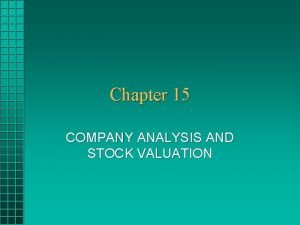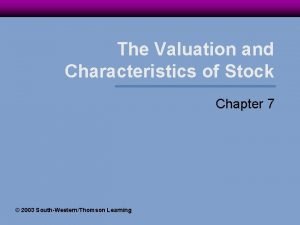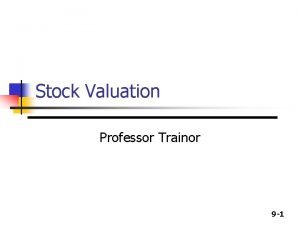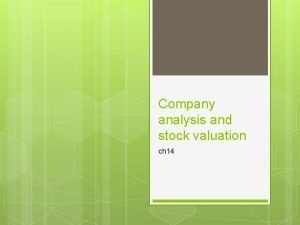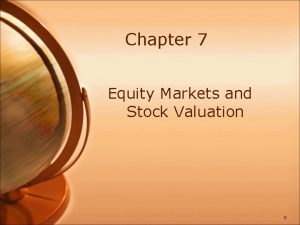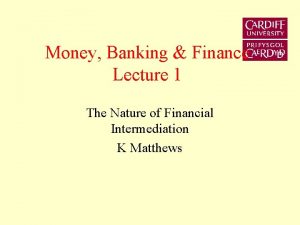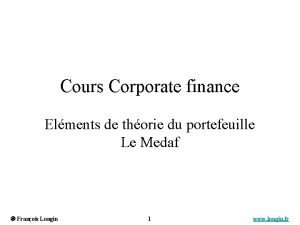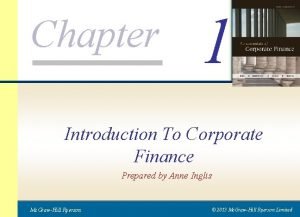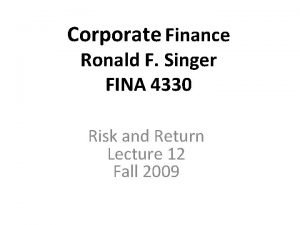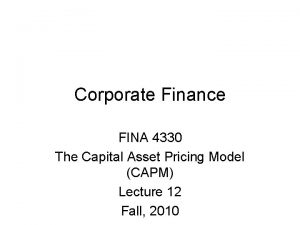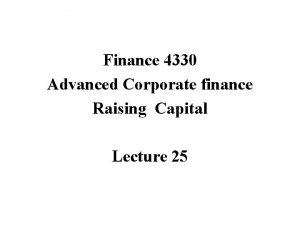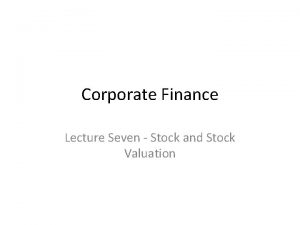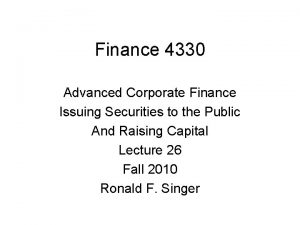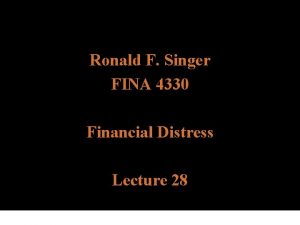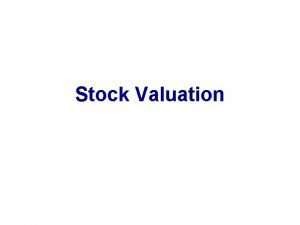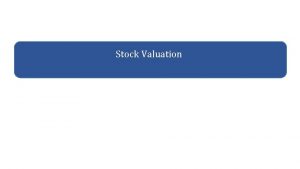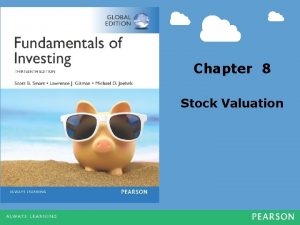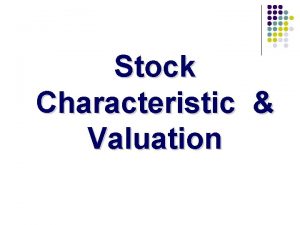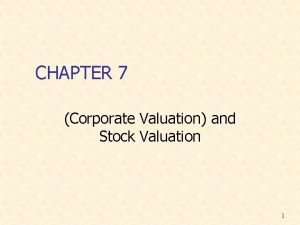Lecture 6 Stock Valuation Corporate Finance FINA 4330















- Slides: 15

Lecture 6 Stock Valuation Corporate Finance FINA 4330 Ronald F. Singer Fall, 2010

Stocks • www. finance. yahoo. com • SPRINT NXTEL CP (NYSE: S) Sprint Nextel (S) (8/21/09) Range: 3. 84 -3. 93 Last Trade: 3. 90 52 wk Range: 1. 35 -9. 35 Trade Time: Aug 21 Volume: 28, 768, 634 Change 0. 07 (1. 83%) Avg Vol (3 m): 42, 768, 900 Prev Close: 3. 83 Market Cap: 11. 22 B Open: 3. 90 P/E (ttm): NA 1 y target Est. 5. 35 EPS (ttm): -1. 02 DIV & Yield N/A (N/A)

Sprint Nextel Corp Current (Annual) Yield = Dividend Price P-E Ratio = Closing Price Current Earnings (ttm) Current = Closing Price EPS P-E Ratio

• Stock Valuation If we solve for Po, the current value of the stock Po = E(Div 1) + E (P 1) 1 + E(R) = The Present Value of the Expected Payoffs to the Stockholder. This can be thought of as simply the Present Value of the Dividend plus the price per share that you expect to receive after a 1 year holding period.

Stock Valuation This relation will hold through time, therefore, P 1 = E (Div 2) + E(P 2) 1 + E(R) Substitute for E(P 1 ) in previous equation: Po = E(Div 1) + E(Div 2) + E(P 2) 1 + E(R) (1 + E(R))2 (1 + E(R)) 2

The Value of Stock This relation will hold through time, therefore, P 1 = E (Div 2) + E(P 2) 1 + E(R) Substitute for P 1 Po = E(Div 1) + E(Div 2) + E(P 2) 1 + E(R) ( 1 + E(R))2 And: Po = E(Div 1) + E(Div 2) + E(Div 3) + E(P 3) 1 + E(R) ( 1 + E(R))2 ( 1 + E(R))3

So in general, we can think of a stock as equal to the present value of a dividend stream over some time period plus what you can get for the stock if you sold it at the end of the time period. That is: In general, Po = T E (Divt) + E(PT) t=1 (1 + E(R))t (1 + E(R))T Or, as the time period gets very large, Present Value of E(PT)----> 0 And the stock price is the present value of all future dividends paid to existing stockholders Po = E (Divt) t=1 (1 + E(R))t

Example: ABC corporation has established a policy of simply maintaining its real assets and paying all earnings net of (real) depreciation out as a dividend. Suppose that: r = 10% Net Investment = ? Current Net Earning per Share is 10. (Ignore Changes in Working Capital) then: EPS(1) = EPS(2). . =. . EPS(t). = 10 Year 1 2 3 . . growth 0 0 dividends 10 10 free cash flow 10 10 and: Po = 10 = 100 . 10

Now let this firm change its policy: Let it take the first dividend (the dividend that would have been paid at time 1) and reinvest it at 10%. then continue the policy of paying all earnings out as a dividend. We want to write the value of the firm as the present value of the dividend stream, the present value of free cash flow and the present value of Constant Earnings Per Share plus PVGO. TIME 1 2 3 . . . EPS 10 11 DIVIDEND 0 11 11 FCFE 0 11 INVESTMENT 10 0 0 Present Value of Dividends 100 Present Value of Free Cash Flow to equity 100 Suppose return on investment were 20%? Suppose it were 5% ?

Capitalized Value of Dividends Consider the value of the stock (or the per share Price of the stock) The basic rule is: The value of the stock is the present value of the cash flows to the stockholder. This means that it will be the present value of total dividends (or dividends per share), paid to current stockholders over the indefinite future. That is: V(o) = E{ Dividend(t)} t=1 (1 + r)t P(0) = E{ DPS(t) } t=1 (1 + r)t This equation represents: The Capitalized Value of Dividends or:

Capitalized Value of Dividends The problem is how to make this OPERATIONAL. That is, how do we use the above result to get at actual valuation? We can use two general concepts to get at this result: They all involve the above equation under different forms. (1) P 0 =EPS(1) + PVGO r (2) P 0 = (FCFE per Share)t t=1 (1 + r)t EPS(1) is the expected Earnings per share over the next period. PVGO is the "present value of growth opportunities. r is the "appropriate discount rate FCFE per share is the Free Cash Flow to Equity per Share that is, the cash flow available to stockholders after the bondholders are paid off and after investment plans are met.

Capitalized Dividend Model Simple versions of the Capitalized Dividend Model DIV(1) = DIV(2) =. . . = DIV(t) =. . . The firm's dividends are not expected to grow. essentially, the firm is planning no additional investments to propel growth. thus: with investment zero: DIV(t) = EPS(t) = Free Cash Flow(t) PVGO = 0 therefore the firm (or stock) value is simply: P 0 = DIV= EPS = FCFE r r r

Constant Growth Model New let the firm plan to reinvest b of its earnings at a rate of return of i through the indefinite future. Then annual growth in earnings, dividends, and the price per share will be a constant equal to: g = b x i, b is the “Plowback Ratio” or (1 – “Payout ratio”) or the Net Investment as a percentage of earnings. i is th Return on Equity (ROE) note that: in the special case that Change in Working Capital is zero: EPS = Would be Free Cash Flow to equity if Net Investment were zero, so that: DIV(t) = (1 - b)EPS(t) = Free Cash Flow to Equity(t) and we can write the valuation formula as: P 0 = DIV(1) = (1 -b)EPS(1) = Free Cash Flow to Equity (1) r - g = EPS(1) + PVGO r

This value of the firm can be represented by vo = EPS 1 + PVGO: r where, PVGO = NPV(t) t=1 (1+r)t Notice: if the NPV’s of future projects are positive then the value of the stock, and its price per share will be higher, given its current earnings and its capitalization rate

General Equation for Firm Valuation • Stock Value can be represented by the PV of a Dividend Annuity plus the predicted stock price at the end of the Annuity Period. • DIV + P(T)
 Objective of corporate finance
Objective of corporate finance Fixed income introduction
Fixed income introduction Corporate valuation model
Corporate valuation model Company analysis stock valuation
Company analysis stock valuation Common stock valuation formula
Common stock valuation formula Characteristics of stock valuation
Characteristics of stock valuation Preferred stock valuation
Preferred stock valuation Company analysis stock valuation
Company analysis stock valuation Inventory grade 12 accounting
Inventory grade 12 accounting Avco stock valuation
Avco stock valuation Equity markets and stock valuation
Equity markets and stock valuation 01:640:244 lecture notes - lecture 15: plat, idah, farad
01:640:244 lecture notes - lecture 15: plat, idah, farad Corporate governance lecture
Corporate governance lecture Indirect finance
Indirect finance Corporate finance cours
Corporate finance cours Chapter 1 introduction to corporate finance
Chapter 1 introduction to corporate finance



